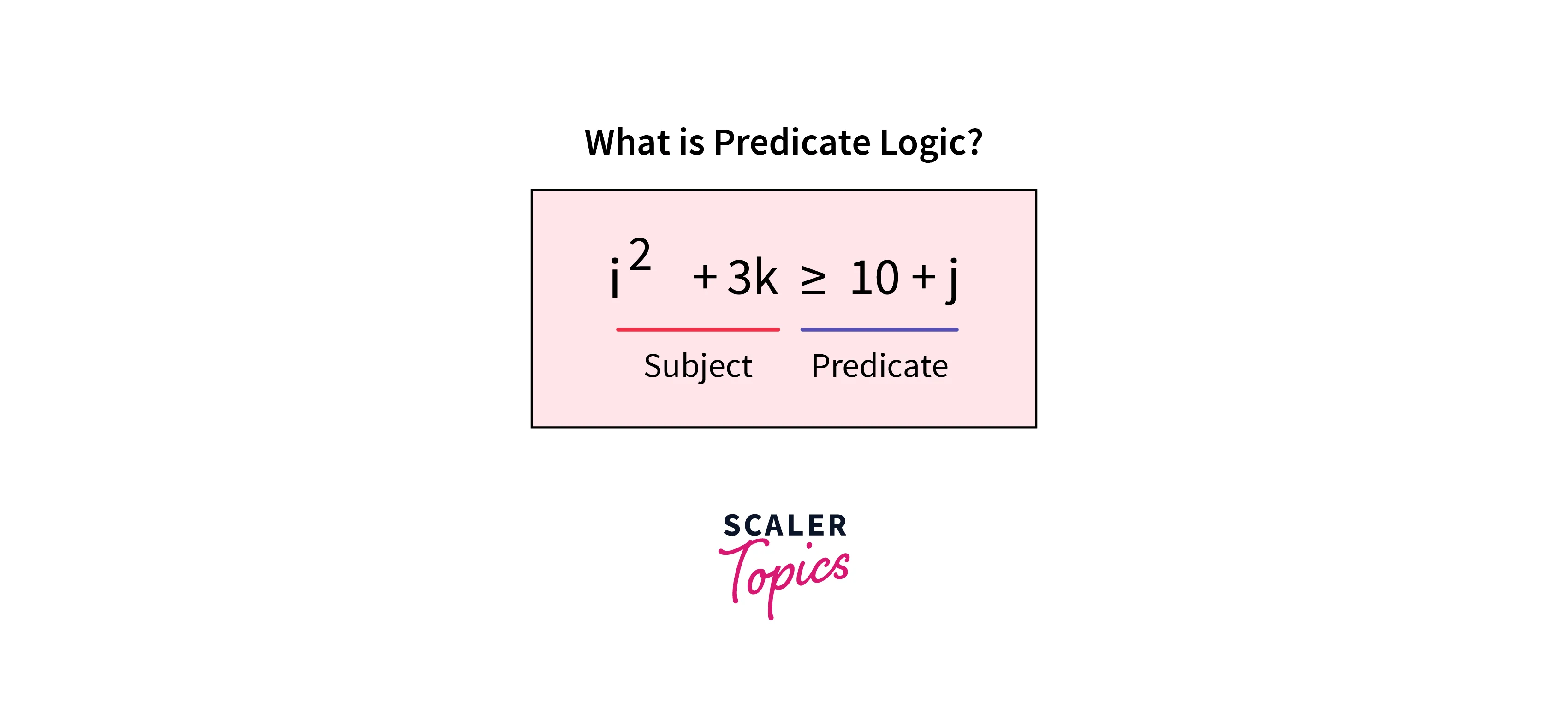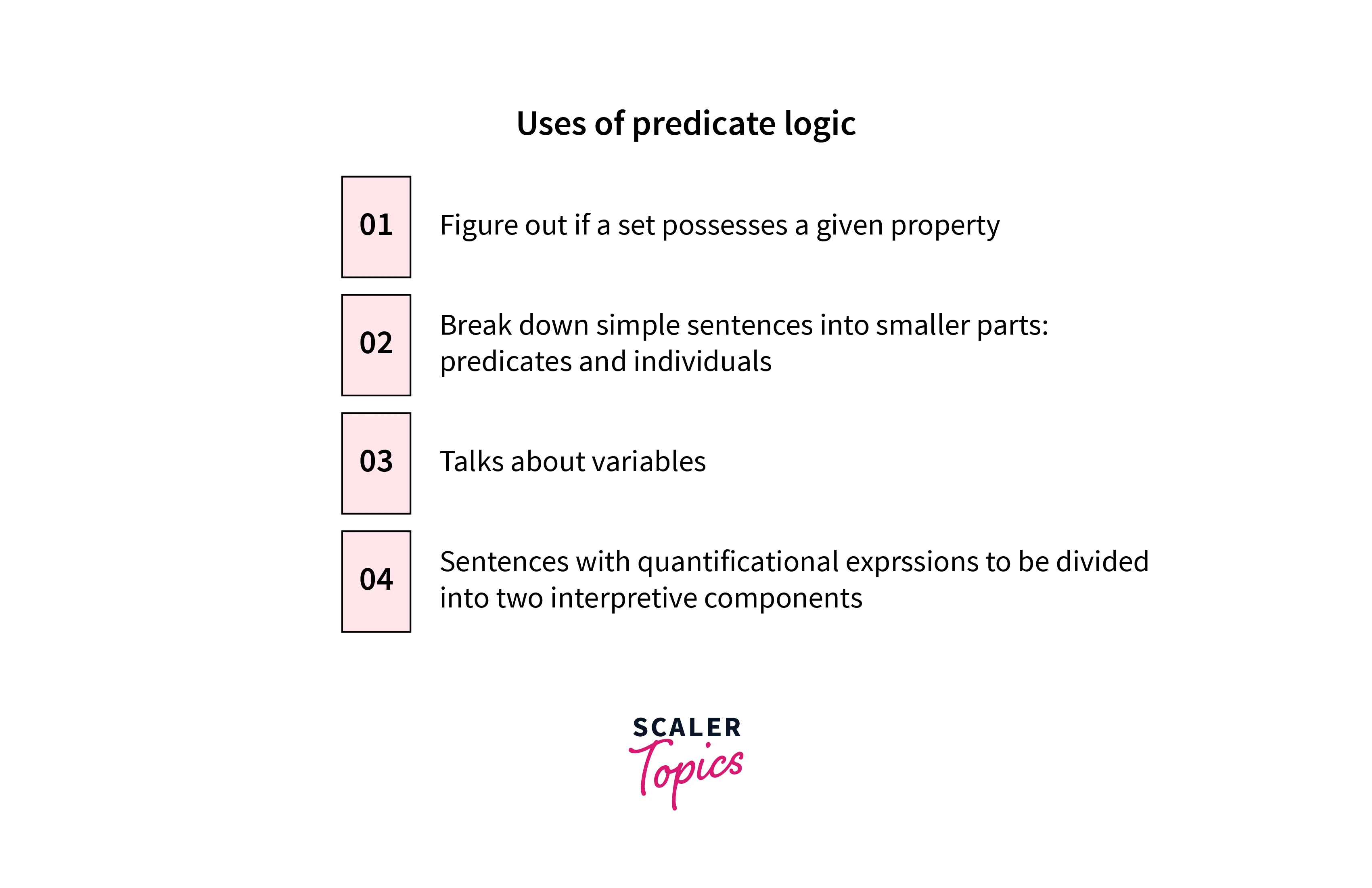Predicate Logic In Artificial Intelligence
Overview
Logic is one of the essential ideas in the field of artificial intelligence. AI systems' reasoning and decision-making are based on logic. It offers a method for presenting and handling data in a way that enables an AI system to draw conclusions and inferences from it.
Predicate Logic in AI is one of the most significant types of logic. Predicate logic in AI is a formal framework for deducing relationships between objects and their qualities. Furthermore, it is a mathematical language that enables knowledge to be expressed precisely and unambiguously, making it perfect for usage in AI systems.
Introduction

Predicate Logic in AI is fundamentally a method for describing and modifying assertions about objects and their characteristics. It includes a collection of rules and symbols that enable us to build complex statements from simpler ones.
Predicates and variables are the core components of Predicate Logic in AI. A predicate is an assertion made regarding one or more things. For instance, the predicate "is blue" declares that a specific item possesses the attribute of being blue. A variable serves as a stand-in for an object so that assertions can apply to any object of a particular type. We can generalize assertions about vehicles by using the variable to represent any car, for instance. There must be at least one object (represented by the variable ) with the quality of being blue, according to the adage "exists , is blue".
The two most common quantifiers are "for all" (represented by the symbol ) and "exists" (represented by the symbol ). For example, the statement "for all , is blue" asserts that all objects (represented by the variable ) have the property of being blue. Likewise, the statement "exists , is blue" asserts that at least one object (represented by the variable ) has the property of being blue.
Characteristics of Predicate Logic
Predicate Logic in AI has several characteristics that make it a powerful tool for AI applications. Some of these characteristics are:
- The Logical inference is allowed.
- More accurate knowledge representation of facts of the real world.
- Program designing is its application area.
- Better theoretical foundation.
- A predicate with no variable is called a Ground Atom.
What is Predicate Logic in AI Example with a Solution?
Let's consider an example of Predicate Logic to understand better how it works. Suppose we want to represent the following knowledge:
"All mammals are warm-blooded."
To represent this knowledge in Predicate Logic in AI, we would use the following symbols:
: is a mammal. : is warm-blooded.
We can then write the knowledge as:
This assertion can be translated as "If x is a mammal, then x is warm-blooded for all x". The symbol describes the conditional relationship between the two predicates and represents the logical connective "implies".
The answer to this example is that we have represented in Predicate Logic in AI the knowledge that all mammals are warm-blooded using the symbols and and the conditional relationship between them using the logical connective "implies".
What are Logical Expressions in Predicate Logic?
In Predicate Logic in AI, logical expressions are assertions made up of predicates, variables, quantifiers, and logical connectives. They are used to represent relationships between things and their properties and infer and deduce from that information.
Logical connectives are used to join together various predicates or logical expressions. For example, the following are the most prevalent logical connectives in Predicate Logic in AI:
- "and" ():
This link expresses the logical union of two predicates. For instance, represents the statement "x is a mammal and x is warm-blooded." - "or" ():
This connective describes the logical disjunction of two predicates. For example, would indicate the statement that "x is a mammal or x is a bird." - "not" (KaTeX parse error: Expected 'EOF', got '¬' at position 1: ¬̲):
This connective conveys a predicate's negation. KaTeX parse error: Expected 'EOF', got '¬' at position 1: ¬̲M(x) for example, would indicate the statement "x is not a mammal." - "implies" ():
The conditional connection between two predicates is expressed using this connective. would symbolise the statement "if x is a mammal, then x is warm-blooded."
Quantifiers are words that are used to make statements about all or some of the things in a domain. "forall" and "exists" are the two most prevalent quantifiers in Predicate Logic in AI. The term "forall" refers to a statement true for all objects in a domain, whereas "exists" refers to a statement true for at least one object in a domain.
For example, to represent the assertion "all mammals are warm-blooded," we could use the statement . The quantifier "forall" indicates that this assertion applies to all objects in the domain.
How Is Predicate Logic Used

In Artificial Intelligence, Predicate Logic is used to describe and reason about complex relationships between objects and their properties. It is especially helpful for formalizing and logically representing knowledge about the world, which can then be used to draw inferences and deductions. For example, predicate logic in AI determines whether a member of a given set holds a given property.
It breaks down basic sentences into smaller parts: predicates and individuals. Predicate logic in AI even allows you to manage generalization expressions(quantificational expressions). Predicate reasoning allows you to discuss variables(pronouns). The pronoun's value is an individual in the universe's domain that context decides.
It allows sentences containing quantificational expressions to be split into two interpretive components. For example, a simple sentence containing a variable or a pronoun (a placeholder) could be evaluated as true or false about a person taken as a value for the pronoun.
The quantificational expression directs you to restrict the domain of people under consideration to a relevant set. It indicates how many distinct pronoun values from a particular domain must be considered to determine the sentence's truth.
What Are the Quantifiers Used in Predicate Logic?
In Predicate Logic in AI, there are two primary quantifiers:
Existential Quantifier
The "Existential Quantifier" ():
This quantifier expresses the statement that at least one object exists in a domain that meets a particular predicate. For example, we could write to indicate "there exists an object x that is both a mammal and a carnivore."
Quantifier Universal
The "Quantifier Universal" ():
This quantifier expresses the assertion that a predicate is true for all items in a domain. For example, to represent the assertion "all mammals are warm-blooded," we could use the statement
The quantifiers can be combined with logical connectives to create more complex logical expressions. For example, we could write to indicate "there exists an object x that is a mammal, and every fish y is an enemy of x."
What Is First-Order Predicate Logic? and Its Example?
First-order predicate logic in AI, also known as first-order logic, is a variety of formal logic that adds quantifiers and predicates to propositional logic. Predicates are used to symbolize properties of objects in first-order logic, and variables are used to represent the objects themselves. Quantifiers are words used to make statements about all or some things in a domain.
Consider the following assertion: "All dogs are mammals." In first-order logic, this assertion could be represented as follows: (Dog(x) Mammal(x)). The variable x denotes any entity in the domain, the predicate Dog(x) denotes the property of being a dog, and the predicate Mammal(x) denotes the property of being a mammal. The quantifier x conveys that this is true for all x objects in the domain.
What Is an Atomic Formula?
In predicate logic in AI, an atomic formula is an assertion that cannot be broken down into simpler statements using logical connectives or quantifiers. It comprises a single predicate symbol and an unlimited number of factors. and are atomic formulas because they cannot be broken down into simpler assertions.
A ground atomic formula is a predicate with all constant arguments. In essence, a proposition would be a predicate without supporting evidence. As a result, it is, by nature, a ground atomic formula. A non-ground atomic predicate has at least one variable argument. An atomic formula or its antithesis would be considered a literal.
Is Predicate Logic Better than Propositional Logic?
The job at hand determines whether predicate logic in AI is superior to propositional logic. Propositional logic is simpler and easy to use for simple statements without variables or quantifiers. It cannot, however, describe object relationships or reason about more complex statements. In contrast, predicate logic is more powerful and flexible, allowing for the representation and reasoning of complicated relationships between things and their properties. However, it is more complex and, for simpler statements, more challenging to use than propositional logic.
Predicate logic is generally favored in Artificial Intelligence applications that demand complex reasoning and representation of relationships between objects and their properties. Predicate logic in AI, for example, can be used in natural language processing to express the meaning of sentences more accurately and precisely than propositional logic. In addition, predicate logic can be used in database systems to describe data relationships in a more structured and organized manner.
Conclusion
- Predicate logic is a formal logic that adds quantifiers and predicates to propositional logic.
- Predicates symbolize the properties of objects, while variables represent the objects themselves.
- Quantifiers are words used to make statements about all or some things in a domain.
- In predicate logic, logical statements include predicates, variables, quantifiers, and logical connectives.
- Predicate logic is used in various applications, including natural language processing and database systems, that demand complicated reasoning and representation of relationships between objects and their properties.
- First-order predicate logic is a form of predicate logic used in many Artificial Intelligence applications.
- In predicate logic, an atomic formula is an assertion that cannot be broken down into simpler statements using logical connectives or quantifiers.
- Predicate logic is preferable to propositional logic depending on the job at hand, with predicate logic favored for applications requiring more complex reasoning and representation of relationships between objects.
